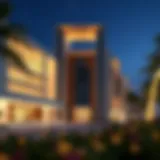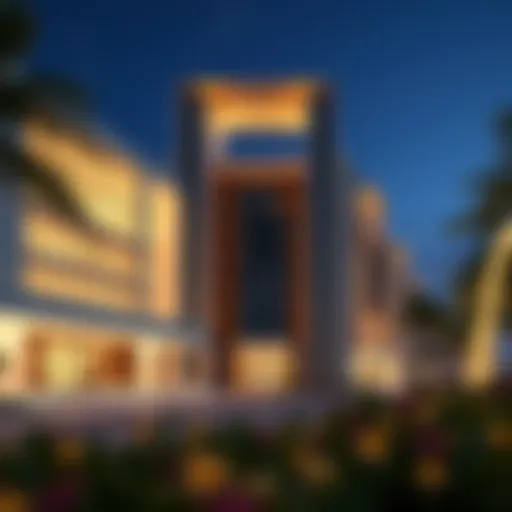Financial Insights on Burj Khalifa's Impact


Intro
Burj Khalifa, standing tall at 828 meters, is not just an architectural marvel but a focal point for financial discussion. As the tallest building in the world, it has become a symbol of Dubai’s rapid growth and its aspirations on the global stage. The sheer scale of the project and investments tied to it raise crucial questions about the financial implications surrounding such an iconic structure. The initial construction cost of around 1.5 billion USD is only the tip of the iceberg.
Its influence extends far beyond its physical presence, impacting the real estate market, tourism industry, and local economy in ways that merit deeper examination. Understanding the financial nuances associated with Burj Khalifa goes beyond mere numbers; it encapsulates the broader narrative of how monumental structures can transform urban landscapes and drive economic vitality.
Market Trends
The financial ecosystem around Burj Khalifa is intricate, influenced by current market dynamics and future potential.
Current Market Analysis
As of 2023, Dubai's property market has witnessed a resurgence, with prices and demand for high-end real estate climbing sharply. The area surrounding Burj Khalifa, known as Downtown Dubai, has been at the heart of this activity. The overall average property price in this vicinity saw an increase of about 15% year-on-year. The presence of the Burj Khalifa adds not only prestige but underscores the desirability of the locale; properties here often command premium prices.
Despite global economic fluctuations, the allure of Dubai as a shopping tourism hub continues to attract significant foreign investments. Investors recognize that residential and commercial properties near landmarks like Burj Khalifa are regarded as safe bets, often yielding higher returns, particularly in the luxury market segment.
Future Predictions
Looking ahead, the forecasts seem promising for the area. Analysts predict that by 2025, property prices could potentially rise another 10% to 20%, spurred by increasing numbers of international visitors and events being hosted in the city. Furthermore, ongoing infrastructural developments, such as the Dubai Metro expansion connecting more areas to Downtown, will bolster access and enhance property values. Investors looking for long-term gains should keep a keen eye on these trends, as the demand for premium properties is unlikely to wane anytime soon.
“The financial dynamics surrounding Burj Khalifa are a testament to how monumental architecture shapes economic narratives and investor confidence.”
Investment Opportunities
Investors should not only consider the immediate implications but also the broader investment landscape highlighted by Burj Khalifa.
High-Return Areas
Among the most promising investments are luxury residential units and upscale commercial spaces in Downtown Dubai. The returns from rental properties in this locality have been substantial. High-Return Areas include:
- Residential Towers: High-end condos often see rental yields of 6% and above, especially around Burj Khalifa.
- Commercial Real Estate: Office spaces catering to multinational companies are in high demand, reflecting substantial growth pinned to global business activities.
Emerging Neighborhoods
Additionally, several up-and-coming neighborhoods like Dubai Creek Harbour and Dubai Marina are capturing interest. As infrastructure and amenities improve, properties in these areas are poised for appreciation, offering more affordable entry points for new investors. Key considerations include:
- Accessibility: Proximity to transit links boosts property value.
- Amenities: Über-modern facilities attract renters and buyers alike.
- Community Development: The establishment of schools, parks, and shopping centers increases desirability in new neighborhoods.
Understanding these investment opportunities is crucial for stakeholders interested in maximizing their returns in Dubai’s evolving market landscape. As the Burj Khalifa continues its reign as an architectural icon, its financial implications will undoubtedly serve as a beacon for future investments and economic development in Dubai and beyond.
For further reading, consider exploring resources from Wikipedia, and Britannica for a broader context.
Intro to Burj Khalifa
The Burj Khalifa stands as a towering testament to human ambition and engineering prowess. This magnificent structure holds the title of the tallest building in the world, and its financial implications extend far beyond mere architectural merit. Understanding the Burj Khalifa is crucial for any analysis regarding significant investments and development trends in urban settings, especially in a city like Dubai where luxury meets innovation.
Overview of Burj Khalifa
Completed in 2010, the Burj Khalifa stretches a staggering 828 meters into the sky, making it an icon not just for Dubai, but for the entire world. The building, designed by Adrian Smith of Skidmore, Owings & Merrill, incorporates a unique pattern inspired by Islamic architecture. However, what is truly compelling about this structure is how its existence reshapes the financial landscape around it.
The tower is more than just a building; it encompasses 163 floors of lavish residences, office spaces, and luxury hotels, attracting a diverse clientele. Real estate agents and investors pay close attention to the developments surrounding this landmark, as property value trends often begin at Burj Khalifa and ripple outward. Not to mention, its observation deck situated on the 148th floor offers breathtaking views, significantly contributing to its revenue generation through ticket sales.
Significance of the Structure
The Burj Khalifa symbolizes Dubai's transformation from a modest desert town to a global metropolis. Its financial significance cannot be understated as it has been a focal point for tourism, real estate investment, and branding opportunities.
Moreover, the cumulative effect of the Burj Khalifa has led to increased foot traffic in the surrounding area, fostering a vibrant market for local businesses. With the influx of tourists, businesses related to hospitality and retail have reported substantial growth since the tower's inception.
Key financial aspects to consider include:
- Increased demand for both residential and commercial properties nearby, with a noticeable uptick in property values.
- A surge in tourism numbers contributing to Dubai’s economy, positioning the city prominently on the global stage.
- Opportunities for corporate sponsorships and high-profile partnerships, showcasing international brands.
The Burj Khalifa is not just an architectural wonder; it's a beacon of financial prosperity that illustrates how monumental structures can redefine economic landscapes.
The implications of the Burj Khalifa extend into various realms of finance, making it a case study in investment viability and urban development strategies. Elevating its skyscraping presence does more than touch the clouds; it influences market dynamics, local economies, and investor interest alike.
Cost of Construction
Understanding the cost of construction is vital when examining the financial implications of the Burj Khalifa. Given its status as the tallest building in the world, the investments channeled into its creation extend beyond mere numbers. Each dollar spent reflects the ambition of Dubai to position itself on the global stage. The intricate web of expenses attached to constructing such a monumental structure highlights both the risks and rewards inherent in undertaking projects of this scale.
The cost structure embodies several key elements: the initial investment breakdown, the labor and material expenses, and the design and engineering costs. Each category contributes significantly not only to establishing the physical monument but also to shaping the economic landscape of the region. Understanding these facets reveals insights into the broader implications of large-scale constructions, including investor sentiment, real estate market trends, and tourism boosts.
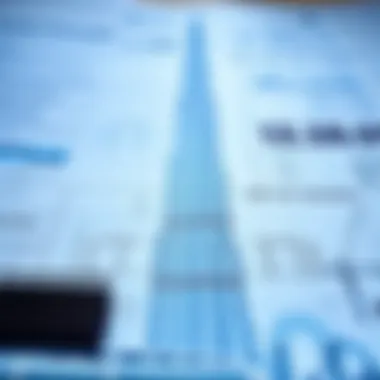

By breaking down these costs, one can better foresee potential returns and the sustainability of such substantial investments. The financial journey of the Burj Khalifa, thus, is multilayered and offers lessons for future developments.
Initial Investment Breakdown
The initial investment in the Burj Khalifa reflects a massive financial commitment. Estimated at about $1.5 billion, this figure does not merely serve as a price tag but rather signals a daring leap towards architectural and economic advancement.
The initial investment encompasses various components:
- Land acquisition costs: Purchasing prime land in Dubai's downtown area.
- Construction financing: Loans and financial instruments regulated by the market.
- Project management: Fees associated with overseeing the scope and timeline.
Such a detailed breakdown reveals that the initial spend is just the beginning. Each segment plays a crucial role in ensuring that the venture is not only viable but also profitable.
Labor and Material Expenses
Labor and material expenses are the backbone of any construction project, and the Burj Khalifa is no different. The project required a specialized workforce, tantalizing more than 12,000 workers at peak periods. These individuals handled everything from concrete pouring to the installation of the tower's innovative systems.
Moreover, the raw materials used were specific to meet the lofty ambitions of the builders. The materials include:
- High-performance concrete: Used for its durability and strength; this was essential for such a towering structure.
- Glass and steel: These materials provide not only aesthetic appeal but structural integrity.
In total, it's estimated that the labor and materials took up a significant portion of the budget—around 55%—a clear illustration of the costs tied to high construction standards.
Design and Engineering Costs
The design and engineering costs for the Burj Khalifa are substantial, reflecting the visionary concept behind the skyscraper. It was crucial to merge aesthetic appeal and engineering prowess in this project. The design itself was a collaboration between renowned architects such as Adrian Smith of Skidmore, Owings & Merrill and local stakeholders.
The expenses associated with design and engineering include:
- Architectural design fees: Paying top-tier talent to conceptualize the structure.
- Engineering consultations: Specializing in structural integrity and environmental considerations.
- Permits and legal fees: Necessary documentation to keep the project on the right side of regulations.
Overall, these costs amounted to nearly 15% of the total budget. They are representative of the importance placed on innovative design in large-scale construction, setting a precedent for future skyscrapers around the world.
Ongoing Maintenance Costs
Ongoing maintenance costs play a crucial role in the long-term financial viability of iconic structures like Burj Khalifa. The towering presence, which has become a symbol of Dubai, requires diligent upkeep; it’s no walk in the park. Regular maintenance ensures safety, aesthetic appeal, and operational efficiency, which are critical for attracting both tourists and business investments. Parts of the tower require meticulous care, particularly given the extremes of the desert climate that can affect materials and systems over time.
Annual Maintenance Plan
Establishing a robust annual maintenance plan for Burj Khalifa is vital to preserving its stature and functionality. This plan typically encompasses various components:
- Structural Inspections: Regular evaluations of the concrete and steel elements to ensure structural integrity and safety. Cracks, leaks, or deterioration require immediate attention.
- Façade Maintenance: The building's glass exterior is not just for aesthetics; it's essential for energy efficiency too. Regular cleaning and checks for wear can help mitigate issues with tarnishing or damage from sandstorms.
- HVAC and Systems Maintenance: The heating, ventilation, and air conditioning systems need frequent upkeep to ensure effective climate control throughout the building.
- Landscaping and Outdoor Areas: The areas surrounding the tower, including parks and walkways, require landscaping maintenance that contributes to the overall appeal and accessibility.
The potential costs can add up fast, requiring well-planned budgeting and resource allocation to keep everything ticking like clockwork.
Utility Expenses
Utility expenses are another significant contributor to ongoing costs, and for a skyscraper like Burj Khalifa, they form a considerable part of the operational budget. These are some of the key utility expenses to consider:
- Electricity Costs: Given the energy demands of such a colossal structure, including lighting for the observation decks and the extensive climate control systems, electricity bills can be substantial.
- Water and Sewage: Adequate plumbing infrastructure is essential, considering that the building houses both residential and commercial spaces, along with visitor amenities.
- Elevators and Escalators: The maintenance and operation of high-speed elevators add to ongoing expenses. Regular inspection and upkeep are crucial for reliability.
"The upkeep of Burj Khalifa is not merely an expense; it is an investment in its future legacy."
For more information on skyscraper maintenance strategies, you can visit Wikipedia or check real estate resources like Reddit.
Revenue Generation Strategies
Analyzing the financial implications of the Burj Khalifa requires a detailed look at its revenue generation strategies. This towering structure serves not just as a breathtaking piece of architecture but also as a vital cog in Dubai's economy. These strategies underscore the financial viability of such monumental constructions, presenting insights applicable beyond the realm of skyscrapers.
Ticket Sales and Observation Deck
The Burj Khalifa's observation deck is one of its prime attractions, drawing millions of visitors from all corners of the globe. Touted as the highest observation deck in the world, it offers unparalleled views of Dubai’s skyline and the sprawling desert beyond. This allure translates into a significant revenue stream, where ticket sales contribute substantially to the overall financial health of the tower.
The pricing for tickets varies based on the time of day and how far in advance they are purchased. This tiered pricing model encourages visitors to plan ahead, often resulting in increased sales during peak tourist seasons. Many tourists are more than willing to pay for the experience, showcasing a strong willingness to invest in memorable experiences. To keep things fresh for returning visitors, the organizers often update exhibits and incorporate interactive elements showcasing Dubai's culture and heritage.
- Key Points:
- Ticket pricing is dynamic, adjusting based on demand and time of visit.
- Emphasis on unique visitor experiences enhances repeat business.
- Special events or themed nights on the deck can further drive revenue.
“The revenue from observation deck ticket sales creates a dependable financial lifeline for the Burj Khalifa, reinforcing its role as a major landmark.”
Real Estate Leasing Opportunities
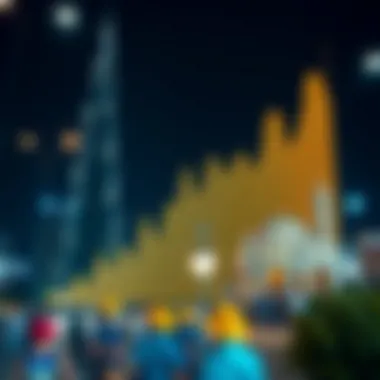

Positioned within the Burj Khalifa is an array of luxurious residential and commercial spaces. The tower is not only a tourist hub but also a prime location for real estate investment. Leasing opportunities within such a prestigious development are highly sought after. Properties here command hefty prices due to the Burj Khalifa’s iconic status and central location in Dubai.
Commercial leases, particularly on lower floors, cater to high-end retailers and restaurants willing to pay a premium for visibility. The allure of conducting business in one of the world's tallest buildings cannot be overstated. Residential leases, on the other hand, attract affluent individuals and families seeking luxury living with breathtaking views.
- Considerations:
- High demand in leasing ensures stable and continuous cash flow.
- Property value appreciation due to the building's iconic status.
- The luxury appeal draws in global tenants, maintaining competitive occupancy rates.
Corporate Sponsorships and Partnerships
Corporate sponsorships and partnerships have emerged as an essential aspect of the revenue model for the Burj Khalifa. This strategy includes collaboration with global brands looking to capitalize on the tower's prestige and visibility. These partnerships can range from promotional events and product launches to sponsorship of specific areas within the tower.
Brands often seek association with the Burj Khalifa to enhance their credibility and highlight their commitment to innovation and luxury. For instance, the tower has hosted numerous events for prominent brands, lending prestige to both the sponsors and the Burj Khalifa itself. Leveraging these partnerships can lead to financial gains while also enriching the visitor experience through additional events and marketing promotions.
- Benefits:
- Increased visibility for brands via association with a global icon.
- Opportunities for joint marketing campaigns that boost footfall to the tower.
- Increased revenue through event hosting and associated ticket sales.
Burj Khalifa's Impact on Real Estate
The Burj Khalifa stands as a monument not only in terms of height but also in its profound influence on the real estate landscape of Dubai and beyond. This towering structure has become synonymous with luxury, innovation, and economic opportunity. The arrival of the Burj Khalifa reshaped the perception of Dubai as a global city, driving investment and tourism and inspiring future architectural endeavors. Let’s explore its impact on the local real estate scene, considering its effects on property values and surrounding developments.
Property Value Trends in the Area
The introduction of the Burj Khalifa into the Dubai skyline has had a noticeable ripple effect on property values in its vicinity. Properties in close proximity to this architectural wonder have seen a surge in desirability. For instance, areas like Downtown Dubai, where the tower is located, have experienced a marked appreciation in real estate prices. Investors and homebuyers flock to these regions, attracted by the iconic status and the luxurious lifestyle associated with living near the world's tallest building.
- Key factors influencing property values include:
- Increased demand driven by attractive amenities and accessibility.
- Enhanced lifestyle offerings, including fine dining, upscale shopping, and entertainment options.
- The tourism boom, generating interest from international and domestic buyers alike.
In particular, residential apartments and commercial units around the Burj Khalifa have outperformed their counterparts in other areas of Dubai. According to recent market reports, the prices for flats near the tower can surpass traditional expectations, indicating a premium on anything with a view of or proximity to Burj Khalifa.
Moreover, the ongoing developments in the region, including new commercial projects and infrastructure enhancements, continue to propel property values skyward. The investment in surrounding areas signals confidence and positive anticipation in the real estate market, suggesting that the Burj Khalifa serves as more than just a building; it is a catalyst for growth.
Influence on Surrounding Developments
The Burj Khalifa has not only impacted property value directly but has also spurred a wave of surrounding developments that cater to the growing interest in the area. Its presence encourages both private and public sector investments, ensuring that infrastructure, services, and amenities keep pace with rising demand.
Examples of such developments include:
- The Dubai Mall, which is one of the largest shopping centers globally, drawing millions of visitors each year.
- New hotels and resorts, enhancing tourist accommodation options and increasing foot traffic to the area.
- Educational institutions and healthcare facilities, which support the growing residential population.
These developments have created a symbiotic relationship. As more businesses establish themselves near the Burj Khalifa, the area becomes more appealing to residents and tourists alike, leading to an ever-increasing desirability. Investors see this as an opportunity, understanding that the vicinity around the Burj Khalifa is not simply a place to live but an area rich with prospects for future gains.
"The Burj Khalifa is fundamentally a powerful attractor, drawing in real estate investment and developing a community that thrives both economically and socially."
In summary, the Burj Khalifa has sown the seeds of transformation in the Dubai real estate market. By boosting property values and inspiring new developments, it advances the narrative of Dubai as an essential hub for international business and luxury living.
Tourism and Entertainment Revenue
The money generated from tourism and entertainment around the Burj Khalifa cannot be overstated. This tall tower has become a beacon of allure, drawing millions of tourists from around the world. It isn't just about visiting a unique architectural marvel; it's about the entire experience that Dubai offers. The Burj Khalifa's existence has transformed the economic landscape of Dubai, boosting both local businesses and the broader hospitality sector.
When visitors come to see the tower, they are often looking for more than just a view from the top. They seek a full adventure. This eagerness for experiences spurs a wide range of financial opportunities including local dining, shopping, and lodging. The surrounding area is bustling with activity, reflecting the significant impact that the Burj Khalifa has on its local economy.
To break it down further, tourism around the Burj Khalifa includes:
- Visitor Spending: Tourists spend on local culture, meals, and souvenirs.
- Event Hosting: The tower serves as a venue for corporate retreats and social gatherings, increasing foot traffic.
- Attraction to Adjacent Developments: Additional projects nearby benefit from the influx of visitors, enhancing the overall community value.
As such, Burj Khalifa extends its reach well beyond its physical structure, impacting many facets of Dubai's economy through tourism and entertainment.
Impact on Dubai's Tourism Industry
The Burj Khalifa stands tall, not only as the highest building but as a cornerstone of Dubai’s tourism. The structure itself has become a pivotal point of reference for international travelers. As per the Dubai Tourism Board, tourism contributes significantly to the emirate's GDP. The majestic tower brings in an astonishing 1.5 million visitors annually, leading to considerable spending on local amenities and services.
Consider how the magnificent viewing deck allows tourists to take in spectacular views of the city amidst a backdrop of desert expanses. This experience is one that many choose to share on social media, effectively acting as free advertisements for the city and its landmarks. Tourism around the Burj Khalifa produces a ripple effect throughout the economy, encouraging diverse sectors:
- Hospitality and Hotels: Increased bookings in hotels around the area.
- Transportation Services: An uptick in taxis and ride-sharing in the vicinity.
- Shopping Destinations: Malls and boutiques nearby see significant foot traffic due to the influx of tourists.
This interconnectedness emphasizes a long-lasting effect on local businesses and tourism strategies, making the Burj Khalifa far more than just a stunning architectural feat but a whole ecosystem of economic activity.
Attraction for International Events
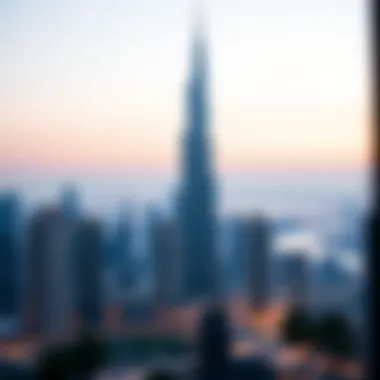

The Burj Khalifa, with its iconic image globally, has become a prime spot for a variety of international events. From celebrity-studded parties to corporate launches, the venue’s reputation enhances the profile of whatever event it hosts. Companies aiming to showcase their products see the tower as a prestigious location that naturally attracts attention.
Additionally, many international sports events and cultural festivals now seek to partner with the Burj Khalifa, dragging crowds in and providing a significant boost in visitor numbers. Specifically, the tower’s ability to function as a canvas for light shows and art displays increases its appeal as a venue. Highlights include:
- New Year’s Eve Celebrations: With magnificent fireworks that draw thousands.
- Cultural Festivals: Various artistic performances that attract diverse crowds.
- Corporate Networking Events: Offering unique settings that enhance brand image.
This versatility as an attraction for international events establishes the Burj Khalifa as a key player in the culinary and entertainment scene, further solidifying Dubai's reputation as a global city. In sum, the tower serves not only as a tourist destination but also as a cultural hub, reflecting the vibrancy and innovation that Dubai represents in the world today.
Comparative Analysis with Other Skyscrapers
The financial implications of the Burj Khalifa can’t be fully appreciated without examining other skyscrapers around the globe. This comparison is crucial for investors, real estate agents, and analysts as it provides context for the costs and revenues associated with such monumental structures. By looking at similar buildings, one can draw insights into market expectations, cost efficiencies, and potential revenue streams.
Cost Comparison with Similar Structures
When one thinks about towering structures, several come to mind. The Taipei 101, for instance, demanded a significant investment of approximately $1.8 billion. Comparatively, the Burj Khalifa’s total cost was about $1.5 billion, which, when adjusted for inflation and other market factors, demonstrates a striking financial efficiency in its construction practices.
- Key Factors Influencing Costs:
- Material Quality: Steel and glass used in Burj Khalifa set a standard, driving up initial costs.
- Engineering Innovations: The use of cutting-edge technologies streamlined construction and reduced waste, allowing for savings.
Some figures might suggest that a higher cost correlates with more extravagant outcomes, but that isn't always the case. For example, the One World Trade Center, despite its staggering $3.9 billion price tag, faced challenges in terms of revenue generation that Burj Khalifa managed to sidestep through diverse income streams.
Revenue Models Compared
Aside from construction costs, how does the Burj Khalifa stack up against its contemporaries in terms of revenue? The return on investment for skyscrapers is not just about ticket sales from observation decks or leasing office spaces. Various models exist, and comparing them can lead investors to make more informed decisions.
- Burj Khalifa's Revenue Streams:
- Observation Deck Entries: Visitors flock to the top for an unparalleled view of Dubai.
- Mixed-Use Spaces: The building hosts luxury residences and offices, further diversifying income.
In contrast, the Shanghai Tower relies heavily on corporate leasing and some tourism, perhaps limiting its revenue potential. The Petronas Towers, while iconic, do not generate the same level of interest for tourists, risking a more stagnant revenue model due to reliance primarily on corporate leasing well below their tourism potential.
"Understanding revenue models is just as important as analyzing upfront costs. The real payoff isn’t just in numbers, but in long-term investment perspectives."
Implications for Future Projects:
- Investors should look at how revenue methods change the landscape of skyscraper viability.
- A comprehensive analysis of costs and revenue against competitors enables a better grasp of market conditions.
In summary, this comparative analysis sheds light on the financial mechanics behind towering buildings. By scrutinizing other skyscrapers, those involved in the real estate market can better gauge the effectiveness of the Burj Khalifa’s financial strategies. The skyscraper landscape is competitive, and understanding benchmarks is fundamental to staying ahead in investments and returns.
Future Projections
The economic future of Burj Khalifa holds significant implications not only for Dubai but for global architectural investments. As one of the tallest towers in the world, Burj Khalifa stands as a beacon of innovation, attracting investors and tourists alike. Understanding the potential for growth in investment and innovations in maintenance is vital for stakeholders as they forge ahead into an increasingly competitive landscape.
Potential for Growth in Investment
Investing in iconic structures like Burj Khalifa can be likened to planting a seed in fertile ground; it may take time, but with the right care, it can yield substantial returns. Over the years, the tower has demonstrated its ability to adapt and thrive in the ever-changing economic climate. Factors that provide strong forecasts for increased investment opportunities include:
- Urban Development Initiatives: Dubai is not resting on its laurels. The government continues to push for expansions and upgrades in the surrounding infrastructure, enhancing the attractiveness of the Burj Khalifa and its locality. Projects like the Dubai Creek Tower and the Dubai Expo are key areas where more investments are likely to flow.
- Tourism Growth: As seen with global tourism trends, cities with landmark attractions often experience higher visitor numbers. Burj Khalifa, being the crown jewel, will benefit immensely from the influx of tourists motivated by both leisure and business. Expectations for future growth in this sector are buoyed by a recovering global tourism industry post-pandemic.
- Real Estate Development: The surrounding areas have seen property values skyrocket, largely thanks to the prestige associated with Burj Khalifa. As more luxury properties emerge in proximity to the tower, investors are likely to seek opportunities that amplify their holdings, cementing the tower's status as a pivotal asset in Dubai's real estate landscape.
Sustainability and Innovation in Maintenance
In the age of climate consciousness, sustainability has transitioned from a beneficial trait to a non-negotiable requirement. Burj Khalifa is not just about height; it’s about how structures can sustainably coexist within their environment. With its energy efficiency initiatives and maintenance innovations, Burj Khalifa projects a forward-thinking image.
Key elements to consider regarding sustainability include:
- Energy Efficiency Features: The tower employs advanced energy-efficient systems, such as a highly efficient cooling strategy and innovative lighting systems that significantly reduce usage. These features not only diminish operational costs but also enhance the building's overall value in an economy increasingly focused on green initiatives.
- Smart Technology in Facility Management: Utilizing IoT (Internet of Things) technologies allows for real-time data on building performance, enabling prompt maintenance interventions. This proactive approach can prolong the life of the structure and keep operational costs in check.
- Recycling and Waste Management: The management employs substantial measures to ensure recycling of unused materials. This commitment extends to using sustainable products and materials during both regular maintenance and renovation phases, further enhancing the building's green credentials.
End
Summary of Financial Insights
The financial journey of the Burj Khalifa stands as a tale of incredible ambition and the complexities tied to monumental construction endeavors. This tower is not just an architectural wonder; it is also a savvy investment that has far-reaching implications for Dubai's economy. The investment breakdown reveals staggering initial construction costs exceeding 1.5 billion dollars, but with meticulous revenue generation strategies, the returns are just as impressive.
Burj Khalifa employs diverse strategies to maintain profitability. Income derives from ticket sales at the observation deck, a thriving real estate leasing market, and partnerships with corporations looking to leverage the iconic status. Each of these channels contributes significantly to sustaining the building’s financial health.
The impact on the surrounding real estate markets is pronounced as well. Properties nearby saw their values surge, a result of the tower’s allure and the increased foot traffic it brings. These trends offer a microcosm of how landmark structures can alter economic landscapes, recalibrating property values and stimulating new developments in the vicinity.
Final Thoughts on Investment Viability
As future projections for Burj Khalifa suggest, potential growth in investments around iconic structures like this one cannot be understated. Emerging trends in sustainability, paired with ongoing innovation in maintenance practices, signal a promising outlook. The financial implications don’t just halt at construction; they extend into the realms of tourism, real estate, and corporate partnerships, painting a picture of sustained profitability.
For investors, the considerations surrounding the Burj Khalifa are nuanced yet offer a tantalizing glimpse into the dynamics of high-stakes investments. The financial model continues to evolve, adapting to market demands and fostering value creation. As Dubai strives to sustain its momentum on the global stage, the Burj Khalifa is likely to remain a focal point of interest, illustrating the balance between ambition and financial prudence in monumental architecture.
"Investing in icons like Burj Khalifa goes beyond mere numbers; it's about understanding their timeless appeal and their role in shaping future landscapes."
For more insights into financial aspects of real estate and iconic structures, check out resources like Britannica or Wikipedia.
Stay tuned for future developments and ongoing assessments on skyscrapers making waves in the financial sector.










